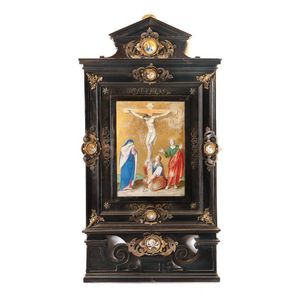Victorian Skeleton Clock by G. H. & C. Gowland
You must be a subscriber, and be logged in to view price and dealer details.
Subscribe Now to view actual auction price for this item
When you subscribe, you have the option of setting the currency in which to display prices to $Au, $US, $NZ or Stg.
- Victorian Period - The Victorian period of furniture and decorative arts design covers the reign of Queen Victoria from 1837 to 1901. There was not one dominant style of furniture in the Victorian period. Designers used and modified many historical styles such as Gothic, Tudor, Elizabethan, English Rococo, Neoclassical and others, although use of some styles, such as English Rococo and Gothic tended to dominate the furniture manufacture of the period.
The Victorian period was preceded by the Regency and William IV periods, and followed by the Edwardian period, named for Edward VII (1841 ? 1910) who was King of the United Kingdom and the British Dominions and Emperor of India for the brief period from 1901 until his death in 1910. - Movement - The technical name for the workings of a clock or watch, and does not include the dial or case.
- Anchor Escapement - An anchor escapement is a type of mechanical escapement used in clocks and watches. It is a refinement of the older verge escapement, which was used in early mechanical timekeeping devices. The anchor escapement is characterised by the use of an anchor-shaped pallet that rocks back and forth, alternately locking and releasing the escape wheel. This action allows the movement of the watch or clock to be regulated, producing the characteristic tick-tock sound that is associated with mechanical timekeeping devices. The anchor escapement is generally more accurate and reliable than the verge escapement, and it is still used in many modern clocks and watches today.
- Fusee - The fusee movement was used in clocks and pocket watches from the mid 17th century. The fusee is a cone shaped drum within the works that is linked to the barrel of the spring, usually by a length of chain.
As the mainspring loses its tension over time, the cone shaped barrel compensates for this by increasing the tension, by pulling the mainspring tighter, thus ensuring the time remains constant.
Use of the fusee in clocks was superseded by the "going barrel" in the mid 19th century and for pocket watches at the beginning of the 19th century.
The fusee continued to be used in marine chronometers until the 1970s. - Chapter Ring - A separate metal plate on the face of a clock, on which the numerals for the hours and sometimes parts of the hours, are displayed, usually wheel shaped and sitting on top of the dial plate. The chapter ring is often a feature of the clock and can be silvered or enamelled to stand as a contrast to its background. The hours are usually shown in Roman numerals, although in the late 19th and earlt 20th century, Arabic numerals became fashionable.
- Circa - A Latin term meaning 'about', often used in the antique trade to give an approximate date for the piece, usually considered to be five years on either side of the circa year. Thus, circa 1900 means the piece was made about 1900, probably between 1895 and 1905. The expression is sometimes abbreviated to c.1900.
This item has been included into following indexes:
Visually similar items

A fine Italian icon, late 18th/19th century, depicting the Crucifixion of Christ, with Mary Magdalene, John the Evangalist, and the Virgin Mary all with him at the foot of the cross, finely painted and mounted in an architectural ebony frame with silvered

A mahogany musical long case marquetry inlaid clock, circa 1880. 248 cm high, 51 cm wide, 34.5 cm deep

A fine early 18th century ebonised Daniel Quare bracket clock of small size, with gilt cherub spandrels, silver chapter ring, strike and silent control with signed arched dial. The twin fusee movement with verge escapement and plumb bob pendulum and a fine

A cobalt blue enamel and ormolu mantel clock, French, 19th century, 37 cm high
